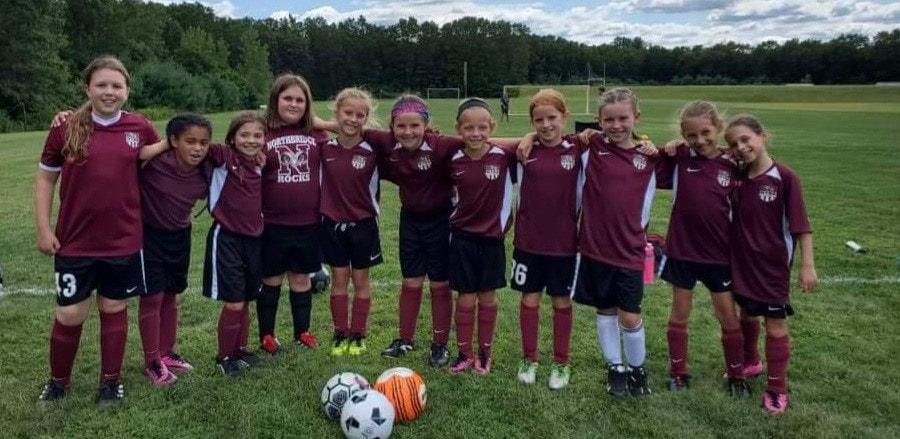This is a crucial age for technical skill development!
Key Objectives for the 10 NYSA Program · Have fun (players, coaches and parents)
For most U10 players
Key Objectives for the 10 NYSA Program · Have fun (players, coaches and parents)
- Players should be sharing the ball
- Begin to learn basic tactics
- Individual, pairs and small group activities up to 3-4 players
For most U10 players
- Are playing on a much bigger field
- May have been taught positions (Wing, Center, Fullback, Keeper) still lack the discipline to play in formation
- Are not used to playing keeper being able to use their hands in goal
- Are not familiar with the 12 yard line
- Are not used to playing teams from other towns or traveling
- Will be playing with and against equally skilled players
Typical Characteristics of U10 Players:
Below is a list of typical expectations and characteristics you can expect from U10 players in the NYSA program:
Below is a list of typical expectations and characteristics you can expect from U10 players in the NYSA program:
- Attention span lengthens from U8
- They start to think ahead, anticipate
- They want to play soccer rather than being told to play
- Demonstrate self-responsibility – bringing a ball, water and all gear should now be their complete responsibility, clean up after games and practices
- They start to recognize fundamental concepts
- Begin to become aware of peer pressure, social status
- Players greatly affiliate with their team or their coach
- Players at this age are rule bound
- There is a wide range of maturity among age
Player Development Skills:
COACHING TIPS FOR U10:
Allow the players to make mistakes and encourage them to make their own decisions. As players progress to U10, they play on larger fields and dribbling may not always be the best option in their minds. Players will need to start understanding when to dribble, when to pass, and when to shoot. They will often choose the wrong option, but as coaches and parents, we need to be patient with them and encourage them to make these decisions independently, especially during games and learn from the results.
Aimless kicking or “booting” of the ball should not be encouraged
The players are aware of the score and many parents/coaches are paying more attention to the results. You will start noticing many coaches/parents yelling directions from the sidelines. We should remind ourselves that improving their play and having fun are the main objectives. We should refrain from yelling directions to the players during games, as it will hamper their ability to make decisions independently. This allows them to learn from the results of their decisions.
Reduce player dependence on adult guidance through “Guided Discovery”
In practice sessions, coaches should try to allow players to make mistakes and ask players how they could do things better. Then we should guide them to the correct answers, rather than telling the players what to do. This will help the players’ ability to solve problems and reduce their dependence on adults for guidance during games.
- Dribble with all sides of both feet (inside, outside, sole) · Dribble out of trouble · Dribble past someone
- Changes of direction (pullback, inside/outside turns)
- Soft first touch · Receiving the ball with inside and outside of feet
- Shielding – develop proper technique to shield the balls from opponents
- Shooting with both feet (with inside of foot and laces) · Shooting for power and accuracy
- Passing with inside and outside of both feet
- Juggling with feet and thighs (allowing one bounce between juggles if needed)
- Basic thrown-in techniques
- Introduce proper defending techniques
- Introduce basic goalkeeping techniques
COACHING TIPS FOR U10:
Allow the players to make mistakes and encourage them to make their own decisions. As players progress to U10, they play on larger fields and dribbling may not always be the best option in their minds. Players will need to start understanding when to dribble, when to pass, and when to shoot. They will often choose the wrong option, but as coaches and parents, we need to be patient with them and encourage them to make these decisions independently, especially during games and learn from the results.
Aimless kicking or “booting” of the ball should not be encouraged
The players are aware of the score and many parents/coaches are paying more attention to the results. You will start noticing many coaches/parents yelling directions from the sidelines. We should remind ourselves that improving their play and having fun are the main objectives. We should refrain from yelling directions to the players during games, as it will hamper their ability to make decisions independently. This allows them to learn from the results of their decisions.
Reduce player dependence on adult guidance through “Guided Discovery”
In practice sessions, coaches should try to allow players to make mistakes and ask players how they could do things better. Then we should guide them to the correct answers, rather than telling the players what to do. This will help the players’ ability to solve problems and reduce their dependence on adults for guidance during games.


